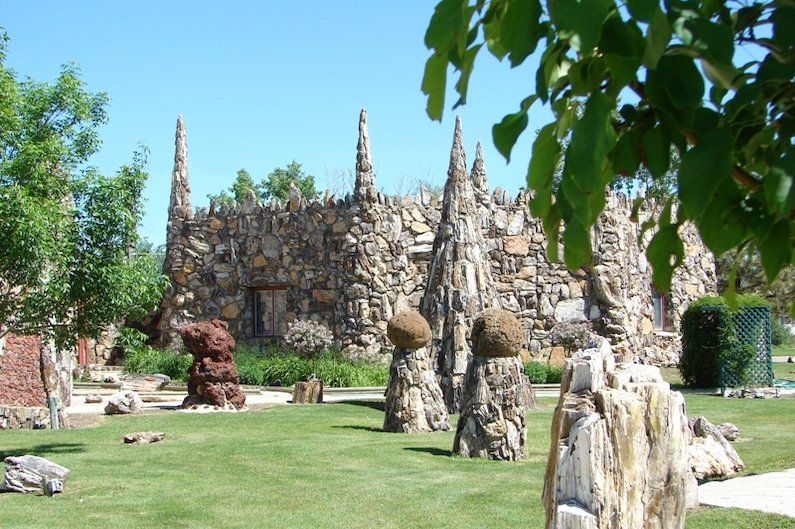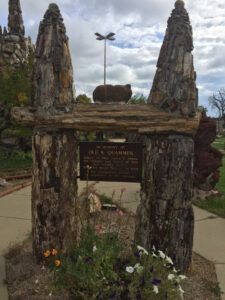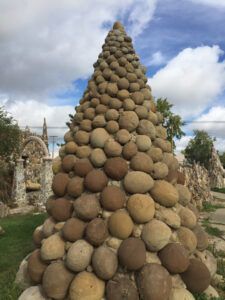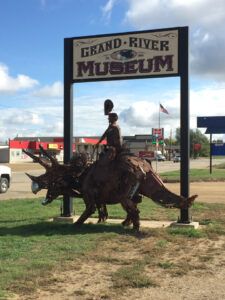Unforgettable South Dakota – Off the Beaten Path – Petrified Wood Park

Petrified Wood Park in South Dakota
By Tom & Patti Burkett
The year was 1930 and, just like everywhere else in the USA, times were tough. In small towns much of the population was living hand to mouth, scrabbling for odd jobs to get the family from one meal to the next. Lemmon, South Dakota was one such small town, but with a difference. Local resident Ole Quammen was an amateur geologist who’d inherited some money from his family—not enough to make him wealthy, but much more than most people had. Quammen saw the despair that was gripping his town and decided to do what he could to improve the lives of his neighbors.
Along the bluffs that edge the northwest corner of what’s now the Buffalo Gap National Grassland, a series of bluffs is constantly eroding. As the soft rock falls away, it reveals agates, rose quartz, and, what most interested Quammen, petrified wood. For three years he paid men from Lemmon to collect specimens from the area and amassed an extraordinary array. He also paid for spherical concretions from South Dakota’s aptly named Cannonball River.

Quammen directed his small army in the construction of a park that takes up nearly an entire city block along the town’s main street. The “Castle” was built from petrified wood logs and an astonishing variety of petrified mammoth and mastodon bones. A second building, housing the Petrified Wood Park Museum, is ringed with spires. Inside are artifacts from the town’s past and daily life on the prairie a hundred years ago.
Near the entrance to the park is a square red stone marker with “SD” on one side and “ND” on the other. This, it turns out, is one of 720 “silent sentinels” placed on the border between North and South Dakota in 1891 and 1892 under the direction of the secretary of the interior. Surveyor Charles Bates opined that the red quartzite monuments, nearly as hard as diamond, “will stand until the judgment day comes.” Well, the line has held, but many of the markers themselves have been displaced by erosion or carted off as souvenirs. Still, many of them can still be found along the border by those walking the grasslands.

The little town of Lemmon, with a population a bit over a thousand, offers another attraction, the Grand River Museum. It’s impossible to miss, with a cowboy mounted on a triceratops out front under the sign. Inside are a variety of fossilized dinosaur bones and skulls. You can take a trip down memory lane typing something on a vintage Underwood typewriter. The nearby Kokomo Inn, once a popular bar, is now the gallery and studio of John Lopez, the sculptor of the statue outside the Grand River Museum. A changing selection of his work is on display, and the side of the building features a mural done by an African artist who was visiting in Lopez’s studio.

A bit north of town is a dispersed camping area at North Lemmon Lake—no amenities, but beautiful views. Right on the border of North and South Dakota, at the edge of the Standing Rock Indian Reservation, Lemmon is two hours from Theodore Roosevelt National Park and three hours from the Badlands. If you happen to be driving one of our favorite roads, US 12 from Minneapolis to Helena, Montana, you’ll go right through town. And you’ll have no doubt that you’re well and truly off the beaten path.
Read More Off the Beaten Path Reports
You can read all the reports from Tom and Patti Burkett right here. Including more from South Dakota!
Get more RV travel ideas, tips, news, and perks!
Each Monday we publish our RV Lifestyle Newsletter, where we share weekly articles about RV travel that inspire and inform. We'll start by sending you a free RV travel checklist. Plus, you become one of our Fellow Travelers, which gets you lots of special perks and RV discounts. It's totally free!
Enter your info below and you are in!
[mc4wp_form id=”49345″]

Thank you for this post. Rocks are an interest of mine. My uncle was a Uranium geologist in the southwest U.S. during the 1950s. A coworker got me started in rock collecting. A few acres I have in northern Az. may contain petrified wood. Keep posting, stay healthy.